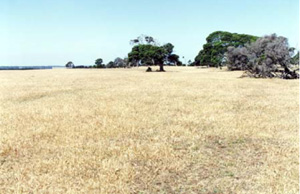OTR489
|
| OTR489 | Ceteric, Pedal, Calcic Calcarosol | |
| Torquay (Torquay football ground) | |||
| Rolling rises/low hills | |||
| Palaeogene Jan Juc Formation/Quaternary alluvium | |||
| Hillslope – upper slope | |||
| - | |||
| South-westerly | |||
Horizon | Depth (cm) | Description | ||
| A1 | 0–10 | Reddish brown (5YR4/4); sandy clay loam; weak crumb structure; clear boundary to: | ||
| B21 | 10–30 | Yellowish red (5YR4/6); medium clay; strong medium (l0 mm) subangular blocky structure; diffuse boundary to: | ||
| B22 | 30–70 | Yellowish red (5YR4/6); medium clay; strong medium (l0 mm) subangular blocky structure; soft accumulations of calcium carbonate; abrupt boundary to: | ||
| C | 70+ | Weathering limestone and marl. | ||
| Management considerations | ||||
| Limestone can provide the calcium so often lacking in Victorian soils but may occur in high concentrations that prove too alkaline for some plants (affecting soil nutrient availability and be restrictive to root movement where close to the surface). The shallow sandy topsoil (generally 10cm or less) has a reduced water holding capacity limiting root growth and high susceptibility to wind erosion. Calcium carbonate nodules (segregations, soft and hard) are derived from the source parent material (limestone). | ||||
Analytical data
Site OTR489 | Sample depth | pH | EC | NaCl | Ex Ca | Ex Mg | Ex K | Ex Na | Ex Al | Ex acidity | FC (-10kPa) | PWP (-150kPa) | KS | FS | Z | C | |
Horizon | cm | H2O | CaCl2 | dS/m | % | cmolc/kg | cmolc/kg | cmolc/kg | cmolc/kg | mg/kg | cmolc/kg | % | % | % | % | % | % |
A1 | 0-10 | 6.5 | N/R | 0.099 | N/R | N/R | N/R | N/R | N/R | N/R | N/R | N/R | N/R | N/R | N/R | N/R | N/R |
B21 | 10-20 | 6.1 | N/R | 0.064 | N/R | N/R | N/R | N/R | N/R | N/R | N/R | N/R | N/R | N/R | N/R | N/R | N/R |
B22 | 30-50 | 6.7 | N/R | 0.113 | N/R | N/R | N/R | N/R | N/R | N/R | N/R | N/R | N/R | N/R | N/R | N/R | N/R |



